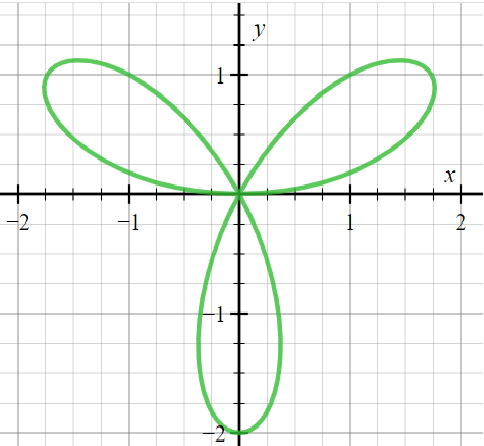
How do I graph a rose curve?
Answer
537.9k+ views
Hint: In this question, we are supposed to show how a rose curve can be done on a graph, and we will solve this with the help of polar equation. We know that the 2-D polar coordinates are \[P\left( {r,\theta } \right),{\text{ }}r{\text{ }} = \;\sqrt {{x^2} + {y^2}} \geqslant 0\]
Complete step by step answer:
The 2-D polar coordinates \[P\left( {r,\theta } \right),{\text{ }}r{\text{ }} = \;\sqrt {{x^2} + {y^2}} \geqslant 0\] It represents length of the position vector \[ < r,\theta > \].θ determines the direction. It increases for anticlockwise motion of P about the pole O.
For clockwise rotation, it decreases. Unlike \[r,\;\theta \;\] admit negative values.
\[r\]-negative tabular values can be used by artists only.
The polar equation of a rose curve is either \[r = a\cos n\theta \] or\[r = a\sin n\theta \]
\[n\] is at your choice. Integer values \[2,{\text{ }}3,{\text{ }}4..\]are preferred for easy counting of the number of petals, in a period. \[n{\text{ }} = {\text{ }}1\]gives 1-petal circle.
To be called a rose, $n$ has to be sufficiently large and integer $ + $ a fraction, for images looking like a rose.
The number of petals for the period $[0,2\dfrac{\pi }{n}]$ will be $n$ or $2n$ (including r-negative $n$ petals) according as $n$ is odd or even, for \[0 \leqslant \theta \leqslant 2\pi \]. Of course, I maintain that $r$ is length \[ \geqslant 0,\] and so non-negative. For Quantum Physicists, \[r{\text{ }} > {\text{ }}0\].
For example, consider\[r = 2\sin 3\theta \]. The period is $2\dfrac{\pi }{3}$ and the number of petals will be $3$.
In continuous drawing, R-positive and r-negative petals are drawn alternately. When n is odd, r-negative petals are same as r-positive ones. So, the total count here is 3.
Prepare a table for \[\left( {r,\theta } \right)\], in one period $[0,2\dfrac{\pi }{3}]$, for \[\theta = 0,\dfrac{\pi }{{12}},2\dfrac{\pi }{{12}},3\dfrac{\pi }{{12}},...8\dfrac{\pi }{{12}}\]. Join the points by smooth curves, befittingly. You get one petal. You ought to get the three petals for \[0 \leqslant \theta \leqslant 2\pi ..\]
For\[r = \cos 3\theta \], the petals rotate through half-petal angle $ = \dfrac{\pi }{6}$, in the clockwise sense.
A sample graph is made for \[r = 4\cos 6\theta \], using the Cartesian equivalent.
It is r-positive \[6\]-petal rose, for \[0 \leqslant \theta \leqslant 2\pi \].
Graph ${({x^2} + {y^2})^3} \times 5 - 4({x^6} - 15{x^2}{y^2}({x^2} - {y^2}) - {y^6}) = 0$

Note: In mathematics, a rose or rhodonea curve is a sinusoid plotted in polar coordinates.
For integer values, the petals might be redrawn, when the drawing is repeated over successive periods.
The period of both \[\sin n\theta \] and \[\cos n\theta \] is $2\dfrac{\pi }{n}$.
Complete step by step answer:
The 2-D polar coordinates \[P\left( {r,\theta } \right),{\text{ }}r{\text{ }} = \;\sqrt {{x^2} + {y^2}} \geqslant 0\] It represents length of the position vector \[ < r,\theta > \].θ determines the direction. It increases for anticlockwise motion of P about the pole O.
For clockwise rotation, it decreases. Unlike \[r,\;\theta \;\] admit negative values.
\[r\]-negative tabular values can be used by artists only.
The polar equation of a rose curve is either \[r = a\cos n\theta \] or\[r = a\sin n\theta \]
\[n\] is at your choice. Integer values \[2,{\text{ }}3,{\text{ }}4..\]are preferred for easy counting of the number of petals, in a period. \[n{\text{ }} = {\text{ }}1\]gives 1-petal circle.
To be called a rose, $n$ has to be sufficiently large and integer $ + $ a fraction, for images looking like a rose.
The number of petals for the period $[0,2\dfrac{\pi }{n}]$ will be $n$ or $2n$ (including r-negative $n$ petals) according as $n$ is odd or even, for \[0 \leqslant \theta \leqslant 2\pi \]. Of course, I maintain that $r$ is length \[ \geqslant 0,\] and so non-negative. For Quantum Physicists, \[r{\text{ }} > {\text{ }}0\].
For example, consider\[r = 2\sin 3\theta \]. The period is $2\dfrac{\pi }{3}$ and the number of petals will be $3$.
In continuous drawing, R-positive and r-negative petals are drawn alternately. When n is odd, r-negative petals are same as r-positive ones. So, the total count here is 3.
Prepare a table for \[\left( {r,\theta } \right)\], in one period $[0,2\dfrac{\pi }{3}]$, for \[\theta = 0,\dfrac{\pi }{{12}},2\dfrac{\pi }{{12}},3\dfrac{\pi }{{12}},...8\dfrac{\pi }{{12}}\]. Join the points by smooth curves, befittingly. You get one petal. You ought to get the three petals for \[0 \leqslant \theta \leqslant 2\pi ..\]
For\[r = \cos 3\theta \], the petals rotate through half-petal angle $ = \dfrac{\pi }{6}$, in the clockwise sense.
A sample graph is made for \[r = 4\cos 6\theta \], using the Cartesian equivalent.
It is r-positive \[6\]-petal rose, for \[0 \leqslant \theta \leqslant 2\pi \].
Graph ${({x^2} + {y^2})^3} \times 5 - 4({x^6} - 15{x^2}{y^2}({x^2} - {y^2}) - {y^6}) = 0$

Note: In mathematics, a rose or rhodonea curve is a sinusoid plotted in polar coordinates.
For integer values, the petals might be redrawn, when the drawing is repeated over successive periods.
The period of both \[\sin n\theta \] and \[\cos n\theta \] is $2\dfrac{\pi }{n}$.
Recently Updated Pages
Master Class 11 Economics: Engaging Questions & Answers for Success

Master Class 11 English: Engaging Questions & Answers for Success

Master Class 11 Social Science: Engaging Questions & Answers for Success

Master Class 11 Biology: Engaging Questions & Answers for Success

Class 11 Question and Answer - Your Ultimate Solutions Guide

Master Class 11 Business Studies: Engaging Questions & Answers for Success

Trending doubts
What is meant by exothermic and endothermic reactions class 11 chemistry CBSE

10 examples of friction in our daily life

One Metric ton is equal to kg A 10000 B 1000 C 100 class 11 physics CBSE

Difference Between Prokaryotic Cells and Eukaryotic Cells

What are Quantum numbers Explain the quantum number class 11 chemistry CBSE

1 Quintal is equal to a 110 kg b 10 kg c 100kg d 1000 class 11 physics CBSE




